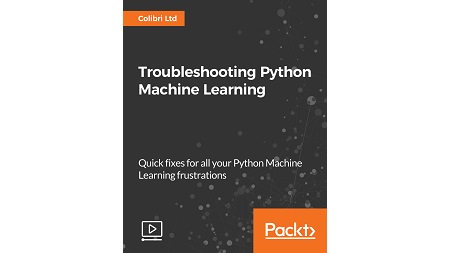English | MP4 | AVC 1920×1080 | AAC 48KHz 2ch | 3h 17m | 414 MB
Practical and unique solutions to common Machine Learning problems that you face. Avoid any roadblocks while working with the Python data science ecosystem.
You are a data scientist. Every day, you stare at reams of data trying to apply the latest and brightest of models to uncover new insights, but there seems to be an endless supply of obstacles. Your colleagues depend on you to monetize your firm’s data – and the clock is ticking. What do you do?
Troubleshooting Python Machine Learning is the answer. We have systematically researched common ML problems documented online around data wrangling, debugging models such as Random Forests and SVMs, and visualizing tricky results. We leverage statistics from Stack Overflow, Medium, and GitHub to get a cross-section of what data scientists struggle with. We have collated for you the top issues, such as retrieving the most important regression features and explaining your results after clustering, and their corresponding solutions. We present these case studies in a problem-solution format, making it very easy for you to incorporate this into your knowledge.
Taking this course will help you to precisely debug your models and research pipelines, so you can focus on pitching new ideas and not fixing old bugs.
The course is full of hands-on instructions, interesting and illustrative visualizations, and, clear explanations from a data scientist. It is packed full of useful tips and relevant advice. Throughout the course, we maintain a focus on practicality and getting things done, not fancy mathematical theory.
What You Will Learn
- Eliminate common data wrangling problems in Pandas and scikit-learn
- Defeat regression and classification difficulties in scikit-learn
- Troubleshoot advanced models such as Random Forests and SVMs
- Wrangling with unsupervised learning and the curse of dimensionality
- Solving prediction visualization issues with matplotlib
- Explaining your results with the most important insights
- Visualizing your decision trees
- Perform common natural language processing featuring engineering tasks
Table of Contents
Eliminate Common Data Wrangling Problems in Pandas and scikit-learn
1 The Course Overview
2 Splitting Your Datasets for Train, Test, and Validate
3 Persist Your Hard Earned Models by Saving Them to Disk
4 Calculate Word Frequencies Efficiently in Good ol’ Python
5 Transform Your Variable Length Features into One-Hot Vectors
Defeat Regression and Classification Difficulties in scikit-learn
6 Finding the Most Important Features in Your Classifier
7 Predicting Multiple Targets with the Same Dataset
8 Retrieving the Best Estimators after Grid Search
9 Regress on Your Pandas Data Frame with Simple Statsmodels OLS
Troubleshooting Advanced Models like Random Forests and SVMs
10 Extracting Decision Tree Rules from scikit-learn
11 Finding Out Which Features Are Important in a Random Forest Model
12 Classifying with SVMs When Your Data Has Unbalanced Classes
13 Computing True_False Positives_Negatives after in scikit-learn
Wrangling with the Unsupervised Learning and Curse of Dimensionality#
14 Labelling Dimensions with Original Feature Names after PCA
15 Clustering Text Documents with scikit-learn K-means
16 Listing Word Frequency in a Corpus Using Only scikit-learn
17 Polynomial Kernel Regression Using Pipelines
Solving Prediction Visualization Issues with Matplotlib
18 Visualize Outputs Over Two-Dimensions Using NumPy’s Meshgrid
19 Drawing Out a Decision Tree Trained in scikit-learn
20 Clarify Your Histogram by Labelling Each Bin
21 Centralizing Your Color Legend When You Have Multiple Subplots
Resolve the captcha to access the links!
